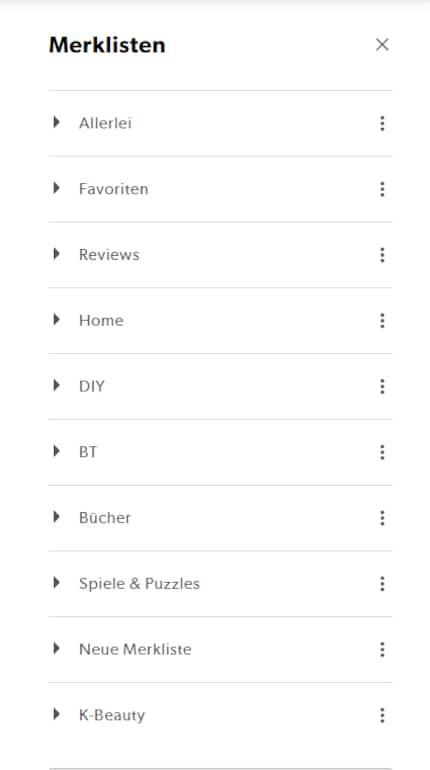
Guide
Get your mum coasters instead of tat this year
by Michael Restin

If I’d approached my past shopping experiences with as much savvy as I do today, my basement wouldn’t be stuffed to the rafters and my savings account would be worth a mention in my tax return. Here are the rules I, an employee of an online shop, follow when buying a product.
Making these lists serves two purposes. For one, it makes me feel like I’m keeping track of things. In some weird, virtual way, it also makes me feel like these coveted items already belong to me.
That’s the lists compiled. So what next?
By the way, the advantage of only making monthly orders is that you have the entire month to get to grips with and enjoy your new purchase, without craving another shopping spree.
Appreciate and use what you already have: I’ve already written about how to see the things you have in a new light.
As a massive Disney fan, I see the world through rose-tinted glasses. I worship series from the 90s and consider mermaids a religion. When I’m not dancing in glitter rain, I’m either hanging out at pyjama parties or sitting at my make-up table. P.S. I love you, bacon, garlic and onions.
Practical solutions for everyday problems with technology, household hacks and much more.
Show all«Why did I even buy that?» is a question I’ve asked myself more often than I’d like to admit during my time working at Galaxus. My very first order was a 27-piece set of piping bag attachments. This would’ve been a reasonable purchase if I a) owned a piping bag in the first place and b) enjoyed baking. None of this applied to me. Nevertheless, when I stumbled across the set while scrolling, an image flashed across my mind’s eye. A different version of myself. I’m baking in the kitchen; a sprinkling of flour dusted across my rosy cheeks, the table in front of me laden with beautifully topped cupcakes, nut-juggling squirrels and singing birds cheering me on from the windowsill. And just like that, I bought it. Maybe it was the pink packaging. I like pink. Whatever it was, it was an impulse buy, mine in just a few clicks, and just one of many:
If your job involves scrolling through pretty things on the internet, these sorts of weaknesses become unaffordable in the long term. Especially when, if my own statistics are anything to go by, nine out of ten purchases wind up in the basement or in the second-hand shop round the corner. So if there’s one thing I’ve learned from working for an online shop, it’s to avoid impulse buys. Although I do still enjoy parting ways with my cash, it mostly goes on things that bring me joy in the long run. To make sure it stays that way, I’ve set out a few basic rules that’ll help you avoid bad buys too.
Most online shops give you the option of creating a watch list. I’ve made one for practically every site I shop with regularly. If something appeals to me, grabs my attention or just screams «must-have», it goes on the list before it has a chance to stray into my shopping cart. And initially, that’s where it stays. It’s the same story on social media, where ads and beauty gurus sell me on products that I didn’t even know existed. Using a save feature, I banish them to a wish list folder. When something takes my fancy in a store, I either take a photo (which, quite rightly, is frowned upon there) or google it and save it as a screenshot.


This is where I start having regular, virtual clear-outs. I continuously look over what I’ve saved and reevaluate it all. Am I still interested in a given book? Is there already a new lipstick out there that I want even more than this one? Do I really need a spiraliser just to try this one zucchini pasta recipe? The more I look at the lists, the more familiar the products seem. Almost like they’ve been here on my shelf for a long time. I get tired of looking at some of them and lose interest. What once seemed new and exciting begins to bore me. So I delete that stuff and give myself a pat on the back. Nice one, you’ve saved some money! What I’m left with is a slimmed-down version of my wish list.
Not everything that hangs onto a spot on my watch list is given the same sense of urgency. That’s why I’ve created a priority list. Which items fulfil a useful purpose? Which ones are just frivolous knick-knacks? This summer, for example, I was able to determine that the pink fan I’d been toying with the idea of buying for weeks was a more worthwhile investment than the nail polish that I only wanted to pair with one particular dress. Once I’ve got my priorities straight, I dive right into reviews, swatches, comparisons, demos and product images from various sources to make sure one last time that yes, it’s exactly what I want!
If I’ve prioritised something, I’ll treat myself – as long as it suits my budget. This is a fixed amount of money I allow myself to spend per month, which makes me happy beyond fulfilling just my basic needs. This doesn’t mean adjusting my budget to the things on my list. It means only putting things in my shopping cart if my budget allows it. Of course, there are exceptions to this, namely more significant purchases such as furniture and travel. This is where the budget can unleash its inner gymnast and stretch right into the splits. Then, on a certain day of the month (payday, cough), I order them all, starting with the highest priority items. If something lacks the budget to get into my shopping cart, I consider it again next time.
**Zero newsletter policy: **If you’re a keen shopper who’s always looking to get the usual 10% welcome discount, you’re bound to be on tonnes of newsletter lists. Unsubscribe from them as soon as you get them. Many a sale, clearance and 2-for-1 offer have tempted me into splashing my cash. The crazy thing is that they lure you in with the potential of saving money, although you’d never have thought to spend it if you hadn’t received the newsletter. These promos’ short validity periods put you under more pressure and to a certain extent, cloud your judgement.
New hobbies and their pitfalls: Maximalists like me don’t start small. They go all in. This also applies to equipment for new leisure activities or interests. No sooner had the yoga group taster session finished, when a gorgeous mat and yoga blocks in a matching colour appeared in my living room. After a 2-hour pottery class, I was already considering whether it would be worth investing in a potter’s wheel. My only issue was finding a place to put the kiln. Hold up.
Sure, a pretty mat might encourage you to do yoga at home, but shouldn’t it be the other way round? Your hobby should bring you so much joy that it doesn’t matter what equipment you start it with. To find out what you really need at home, use what you’ve learned outside of it. Maybe something you have already will do the trick. Or maybe you’ll only realise after a certain amount of time that you’d prefer a mat with a particular material, thickness or slip-resistance. When it comes to functional items, snap decisions almost always lead to bad buys.
Swap sides: Jump to the other side of the virtual counter. Sell something. I know it sounds strange, but getting rid of stuff on resale platforms and earning money for it reassures my inner penny-pincher. I realise that the junk I have at home has value. What’s more, I create more space at home for the things I love and appreciate. Not to mention the fact that selling is just as much fun as shopping, because you also get a reward at the end of it, albeit in a different way. And yes, at some point you can spend the money again. Just spend it on something meaningful.